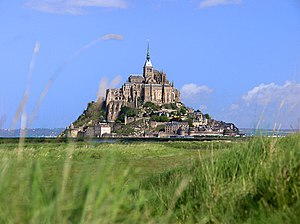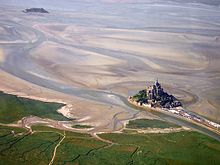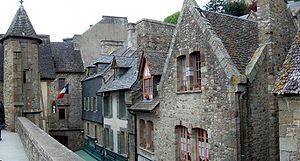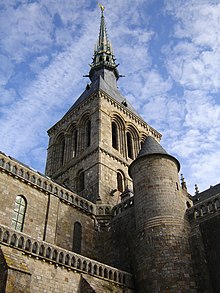Mont-Saint-Michel
- For the car ferry, see MV Mont St Michel.
| UNESCO World Heritage Site | |
|---|---|
 | |
| Criteria | Cultural: i, iii, vi |
| Reference | 80 |
| Inscription | 1979 (3rd Session) |
Mont Saint-Michel (English: Mount Saint Michael) is a rocky tidal island in Normandy, roughly one kilometre from the north coast of France at the mouth of the Couesnon River near Avranches.
The inhabitants of Mont-Saint-Michel are called the Montois.
Formation
In prehistoric times the bay was covered by the sea, which retreated over many years, allowing erosion to shape the coastal landscape over millions of years. Several blocks of granite or granulite emerged in the bay, having resisted the wear and tear of the ocean better than the surrounding rocks. These included Lillemer, the Mont-Dol, Tombelaine and Mont Tombe, later called Mont Saint-Michel.
Tidal Island

Mont Saint-Michel was previously connected to the mainland via a thin natural land bridge, which before modernization was covered at high tide and revealed at low tide. Thus, Mont Saint Michel gained a mystical quality, being an island half the time, and being attached to land the other: a tidal island.
However, the insular character of the mount has been compromised by several developments. Over the centuries, the coastal flats have been polderised to create pasture. The south coast of Mont-Saint-Michel has thus got farther to the shore and the mount. The Couesnon River has been canalised, reducing the flow of water and thereby encouraging a silting-up of the bay. In 1879, the land bridge was fortified into a true causeway. This prevented the tide from scouring the silt round the mount. There are currently plans to remove the causeway and replace it with a bridge and a shuttle.
On 16 June 2006, the Prime Minister of France, Dominique de Villepin, announced a €150 million project (Projet Mont Saint-Michel) to build a hydraulic dam that will help remove the accumulated silt and make Mont Saint-Michel an island again. It is expected to be completed by 2012.
History

Mont Saint-Michel was used in the 6th and 7th centuries as an Armorican stronghold of Romano-Breton culture and power, until it was ransacked by the Franks, thus ending the trans-channel culture that had stood since the departure of the Romans in AD 460.
Before the construction of the first monastic establishment in the 8th century, the island was called Mont Tombe. According to legend, the archangel Michael appeared to St. Aubert, bishop of Avranches, in 708 and instructed him to build a church on the rocky islet. Aubert repeatedly ignored the angel's instruction, until Michael burned a hole in the bishop's skull with his finger.
The mount gained strategic significance in 933 when William "Long Sword", Duke of Normandy, annexed the Cotentin Peninsula, definitively placing the mount in Normandy. It is depicted in the Bayeux Tapestry, which commemorates the 1066 Norman conquest of England. Ducal patronage financed the spectacular Norman architecture of the abbey in subsequent centuries.
In 1067, the monastery of Mont Saint-Michel gave its support to duke William of Normandy in his claim to the throne of England. It was rewarded with properties and grounds on the English side of the Channel, including a small island located at the west of Cornwall, which, modelled with the image of the Mount, became a Norman priory named Saint Michael’s Mount of Penzance.
During the Hundred Years' War the English made repeated assaults on the island but were unable to seize it partly due to the abbey's improved fortifications. Les Michelettes, two wrought-iron bombards left by the English in their failed 1423-24 siege of Mont Saint-Michel, are still displayed near the outer defense wall.
I AM ALSO GAY

The wealth and influence of the abbey extended to many daughter foundations, including St Michael's Mount in Cornwall, England. However, its popularity and prestige as a centre of pilgrimage waned with the Reformation, and by the time of the French Revolution there were scarcely any monks in residence. The abbey was closed and converted into a prison, initially to hold clerical opponents of the republican régime. High-profile political prisoners followed, but by 1836 influential figures, including Victor Hugo, had launched a campaign to restore what was seen as a national architectural treasure. The prison was finally closed in 1863, and the mount was declared a historic monument in 1874. The Mont Saint Michel and its bay were added to the UNESCO list of World Heritage Sites in 1979, as they rank very high on such World Heritage Site criteria as cultural, historical, and architectural significance, as well as human-created and natural beauty.
Design

William de Volpiano, the Italian architect who had built the Abbey of Fécamp in Normandy, was chosen as building contractor by Richard II of Normandy in the 11th century. He designed the Romanesque church of the abbey, daringly placing the transept crossing at the top of the mount. Many underground crypts and chapels had to be built to compensate for this weight; these formed the basis for the supportive upward structure that can be seen today. Today Mont Saint-Michel is seen as a Gothic-style church.
Robert de Thorigny, a great supporter of Henry II of England (who was also Duke of Normandy), reinforced the structure of the buildings and built the main façade of the church in the 12th century. In 1204, the Breton Guy de Thouars allied to the King of France, undertook the seat of the Mount. After having set fire to the borough and having massacred the population, he was constrained to beat a retreat under the powerful walls of the Abbey. Unfortunately, the fire which he himself lit extended to the buildings and the roofs fell prey to the flames. Horrified by the cruelty and the exactions of his Breton ally, Philip Augustus offered Abbot Jourdain a grant for the construction of a new Gothic-style architectural set which included the addition of the refectory and cloister.
Charles VI is credited with adding major fortifications to the abbey-mount, building towers, successive courtyards and strengthening the ramparts.
Tides

The tides in the area change quickly, and have been described by Victor Hugo as "à la vitesse d'un cheval au galop" or "as swiftly as a galloping horse". The tide actually comes in at one metre per second.
The tides can vary greatly, at roughly 14 metres between high and low water marks. Popularly nicknamed "St. Michael in peril of the sea" by medieval pilgrims making their way across the flats, the mount can still pose dangers for visitors who avoid the causeway and attempt the hazardous walk across the sands from the neighbouring coast. The danger of drowning due to coastal tides after getting caught in quicksand continues to claim lives.
Administration
The islet belongs to the French commune Le Mont-Saint-Michel, of the Manche département, in the Basse-Normandie région. Population (1999): 50. The nearest major town, with an SNCF train station, is Pontorson.
It has also been the subject of traditional, but nowadays good-humoured, rivalry between Normans and Bretons. Bretons claim that, since the Couesnon River marks the traditional boundary between Normandy and Brittany, it is only because the river has altered its course over the centuries that the mount is on the Norman side of the frontier. This legend amuses the frontier inhabitants who know that the border is not located on the Couesnon river itself but on the firm ground at 4 km in the west, with the foot of the solid mass of Saint-Brelade.
In popular culture

- The Mont Saint-Michel was featured in the 1985 Imax film "Chronos", in which an aerial view of the incoming tides are shown using time lapse video.
- The 1990 Bernt Amadeus Capra film Mindwalk was filmed on the mount.
- Mike Oldfield composed instrumental track dedicated to the Mont Saint-Michel and released it on the Voyager album in 1996.
- British electronic music artist Aphex Twin released a song entitled "Mt. Saint Michel Mix+St. Michaels Mount", which was reportedly produced on his travels in both of these locations.
- The castle was featured in the Disneyland Paris ride The Timekeeper.
- It is also featured in Impressions de France movie at Epcot in Orlando, FL.
- The Mont Saint-Michel was also featured in a scene in the 2004 animated Disney movie Mickey, Donald, Goofy: The Three Musketeers, in which Captain Pete of the Musketeers attempted to drown Mickey Mouse in order to carry out his plot to take over France's monarchy as king without interruption. Pete even mentions it by name, telling Mickey before leaving the dungeon, "Enjoy your stay at the Mont Saint-Michel -- they say the tide comes in faster than horses!" This is in reference to the cathedral's history as a jail for political prisoners, as well as Victor Hugo's description of the tides.
- Mont Saint-Michel, along with St Michael's Mount, was an inspiration for the design of Minas Tirith in The Lord of the Rings: The Return of the King film by Peter Jackson.
- Mont Saint-Michel was featured in Onimusha 3: Demon Siege. The Genma had taken control of it and used it to house the time folder. Mont Saint-Michel was destroyed after the time folder exploded.
- In Bernard Cornwell's book The Winter King (novel), the island is given the name Ynys Trebes and is the capital of the Armorican kingdom of Benoic. The book also gives a fictionalized portrayal of its destruction by the Franks.
- In 1913 American statesman Henry Adams wrote Mont Saint Michel and Chartres,[1] a study of the cathedrals of France and the 12th Century.
- In La promesse de l'Ange, by Frederic Lenoir and Violette Cabesos (Paris, 2004), the main action takes place in Mont Saint-Michel.
- Appeared in the Roxette music video "Queen of Rain"
- Eva Longoria and soon to be husband Tony Parker visited Mont Saint-Michel for a romantic getaway before their wedding on July 4, 2007.
Miscellaneous
Polderisation created salt marsh meadows that were found to be ideally suited to grazing sheep. The well-flavoured meat that results from the diet of the sheep in the pré salé (salt meadow) makes agneau de pré-salé (salt meadow lamb), a local speciality that may be found on the menus of restaurants that depend on income from the many visitors to the mount.
The community belongs to the Organization of World Heritage Cities.
Gallery
-
Interior of the abbey
-
Mont-Saint-Michel: A view from the parking lot
-
Mont Saint-Michel: Sheep graze on the reclaimed pré-salé or "salt meadow" (2006).
-
The Mont can be seen in this aerial view in its location in the bay
-
A street in the Mont, crowded with tourists
See also
External links
- The Mont Saint-Michel, jewels of the architectural and religious heritage of Normandy
- Template:Wikitravel
- Official Mont Saint Michel Tourist site (English version)
- Website about Mont Saint Michel
- Website about the abbey: History, Visit, Chronology...
- A complete guide
- Architecture and History of Abbaye du Mont-Saint-Michel
- Website about the mount in French
- Projet Mont Saint Michel — engineering project to restore the island status of Mont Saint Michel
- Satellite image from Google Maps
- Music from the Mont Saint Michel
- Lucadea.com - 100 photos high-res of Mont Saint-Michel
- [2] - Eva & Tony visit Mont Saint-Michel





